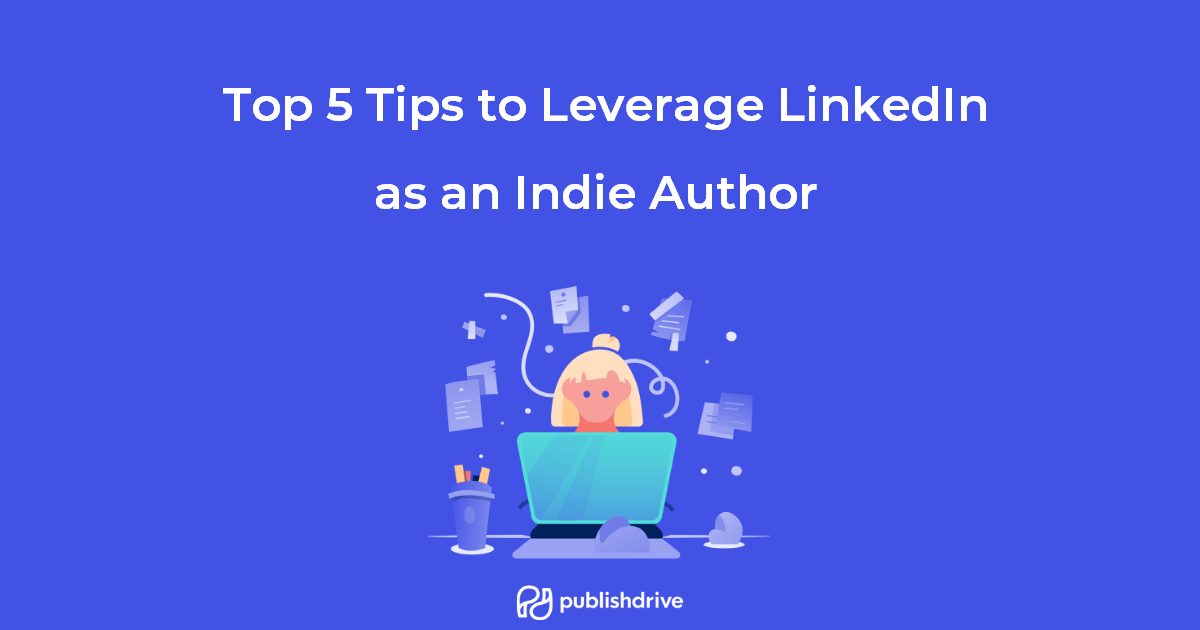Top 5 Tips to Leverage LinkedIn as an Indie Author

This article was written with the help of Gary Collins, bestselling author of the “Living Off The Grid” and “The Simple Life” book series. In addition to being a bestselling author, he has taught at the university college level, consulted and trained college level athletes, and been interviewed for his expertise on various subjects by CBS Sports, Coast to Coast AM, The RT Network, and FOX News.

You’ve probably heard some of your friends mentioning: “A headhunter tracked me down on LinkedIn, and I got a new job,” or, “I made a new business partnership via LinkedIn.” LinkedIn is a great tool for professional advancement in most industries, but did you know it can even boost your author business?
In this article I’ll introduce you to the world of LinkedIn and how to make the best use of LinkedIn for authors. To better showcase the main benefits, I interviewed Gary Collins, the bestselling non-fiction author who uses LinkedIn extensively to build his author business.
What Is LinkedIn?
LinkedIn is like a constant online conference or networking event where you can meet representatives of all industries and all businesses. Essentially, it’s like a “Facebook for Professionals,” offering all the tools you need for business. You can use LinkedIn for:
- Job searches: get hired at your dream company.
- Recruiting: hire someone else.
- Sales: build your small business with new leads.
- Reputation: build your professional brand.
Why is LinkedIn Important for Authors?
I started to use LinkedIn in 2012 and now I have over 8,000 followers. Over the years, I’ve learned how to successfully build a following and fully leverage this social media platform. My follower base is pretty broad; most of them are based all over the US and in Europe.
If you are an author or an indie publisher, LinkedIn is an essential way to build your professional presence besides the regular social media channels, like Instagram, Facebook, and Twitter. Why? It’s not the most obvious answer, as most of you will not find readers there, unless you are publishing non-fiction (especially self-help, STM, academic, or business books).
The main reason for using LinkedIn as an author is to build your credibility in the industry and network with other authors for possible partnerships. Gary echoed this strategy when I asked him what he uses LinkedIn for: “I use LinkedIn for networking with like-minded people who are involved in businesses that relate to my business interests or the topics of my books.”
The great thing about LinkedIn is that any author can easily get started. Let’s look at the top 5 tips to make the best use of LinkedIn for authors.
How to Make the Best Use of LinkedIn for Authors
LinkedIn is the best platform to build your author brand in the professional environment. Whether you write fiction or non-fiction, you can utilize the various features LinkedIn offers to build your small author business.
1. Build Your Publishing Team
The number one step you should take with every book project is to build your author team. You need a reliable editor, cover designer, distributor, marketer, etc. LinkedIn is a great resource for seeking out people who have the skills you need.
Some authors socialize in Facebook groups and forums, but when it comes to doing business together, many prefer to talk on LinkedIn. This is because there is less noise and chatter on LinkedIn, allowing authors to focus on business and potential co-authoring projects. For example, I was personally contacted by editors who invited me to be involved in a book project about female entrepreneurship. Through this connection, I was able to meet wonderful female leaders virtually and chat about future opportunities.
2. Get Featured in the Media or on Influencers’ Blogs
Many influencers and media people use LinkedIn to search for the next big story to cover. Newsworthy topics include success stories that motivate others to make their dreams come true. Gary told me that being active on LinkedIn has helped him get featured in the media numerous times. “I have been featured in media through connections via LinkedIn over the years,” he said. “It has been done in two ways: people finding me because of my background or me reaching out to people who are involved in the media.”
Even better, some influencers hang out on LinkedIn to look for other people to work with to grow their follower base. My advice would be to get their attention: feature them on articles, tag them on posts, comment on their activity, or even make a useful connection for them. I promise, you’ll get noticed!
3. Get Speaking Gigs
Networking with people in your industry is essential to boosting your career as an author. In addition to providing valuable publishing advice, industry people can often connect you with speaking opportunities. I personally received many invitations to speak at various tech or publishing conferences via Linkedin messages.
According to Gary, he’s able to book speaking engagements every week on podcasts, radio shows, and other events thanks to his Linkedin presence. “I receive invitations mostly from people reading my profile,” Gary said, “and reaching out via my email contact on LinkedIn.”
4. Leverage LinkedIn for Conferences
Attending conferences and staying active on LinkedIn work hand-in-hand to build your author brand. Before attending a conference, I often use LinkedIn to find the best people to meet once I’m at the conference. The best part is that in many cases, people add me as a connection during my research, even though I was just looking at their LinkedIn profiles.
After that, messaging them was more natural, and meeting in person was simply phenomenal: as we all know, even in the virtual world you need a personal touch. A perfect example of this was when I was invited as a speaker at a tech conference and my LinkedIn profile was featured. I received over 1500+ connection requests the next day!
Whenever you make a new in-person connection at conferences, be sure to also follow up with them on LinkedIn. This small gesture can help you stay connected and nurture these relationships into potential partnerships.
5. Grow Your Reader Base
LinkedIn is not a usual place to hangout with your readers, unless you write non-fiction, STM, business, or academic books. But when it comes to sharing a behind-the-scenes experience (such as an interview with your favorite expert, or key takeaways from your writing/author business) LinkedIn is a great place to publish an article and then funnel readers to your website.
Though, you have to make it clear on your LinkedIn profile that you’re an author. When setting up your account, be sure to:
- Use a professional profile photo, preferably holding some of your books
- Have a LinkedIn cover photo with your books listed and/or mentioning your website
- Include “Author” in your Headline and Current Position
- In the Description, include an enticing blurb about why readers should read your books
Gary shared my thoughts about not initially viewing LinkedIn as a potential platform to connect with readers. As Gary explains:
“I didn’t think LinkedIn was a place to increase my readers at first, but I found by listing all my books and posting blog post updates people were buying my books on LinkedIn. The advice I would give authors is do not use LinkedIn like other social media and pound people with updates or marketing. Use it as a tool to share occasional updates or interesting articles you have written. I only post the launch of my new book once, as it is already listed in my profile. Also, if you are looking to connect with the media and be a guest on podcasts, it is a great place to search for people who might be interested in your books or what you have to say."
You can also use LinkedIn tools like Kleo to boost audience engagement.
Closing Thoughts
All the above tactics will give you more visibility for potential readers, but they’re only effective if you invest in your LinkedIn strategy for the long run. You have to post and engage with people regularly, but it’s worth it. I’ve experienced firsthand how these virtual connections have boosted my career, and I can assure you that this strategy will help you grow your author business as well.
Take the Next Step – Publish Your Book!
Once you’ve refined your LinkedIn strategy, take the next step and publish your book! Consider using PublishDrive; we can publish and distribute your book in over 400 online stores, including Amazon, Barnes & Noble, Apple Books, Google Play, and Kobo. We also offer free ebook conversion, royalty splitting for co-authors, and built-in marketing tools to boost sales.
It’s free to publish your 1st ebook on PublishDrive. Or try out a paid plan and get your money back if you’re not satisfied.